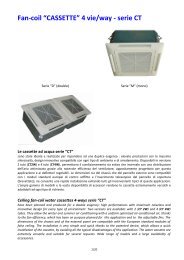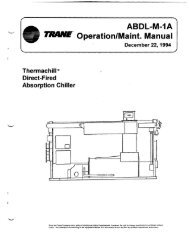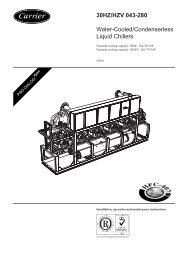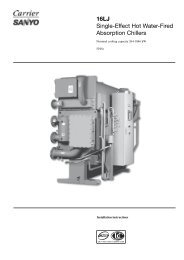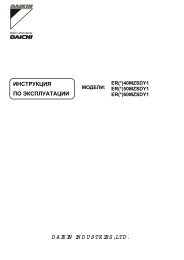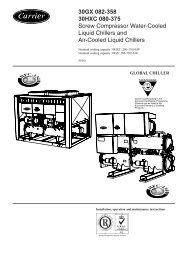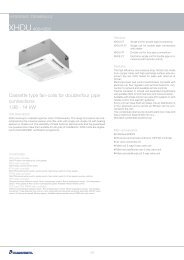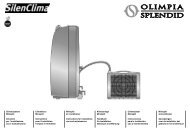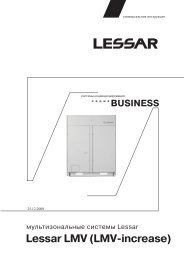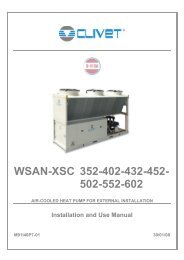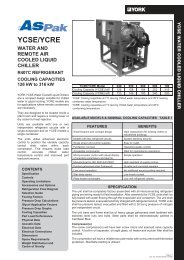MSAT 102-122-142-162-182-202-242
MSAT 102-122-142-162-182-202-242
MSAT 102-122-142-162-182-202-242
Create successful ePaper yourself
Turn your PDF publications into a flip-book with our unique Google optimized e-Paper software.
GENERAL RISKS<br />
Particular area Danger Modality Instructions<br />
Heat exchanger coils Superficial wounds Contact Avoid incidental contacts.<br />
Wear protective gloves.<br />
LP Safety Valves<br />
Area surrounding the<br />
unit<br />
Area surrounding the<br />
unit<br />
Wounds<br />
Intoxication<br />
Wounds<br />
Intoxication<br />
Serious burns<br />
Death<br />
Death by:<br />
Serious burns<br />
Intoxication<br />
Refrigerant gas exhaust<br />
due to the intervention of<br />
the safety cut-out.<br />
Explosion due to a rise<br />
in ambient temperature<br />
(fire).<br />
Fire due to short-circuit<br />
or overheating of the<br />
power supply cables<br />
before the unit mains<br />
switch.<br />
Unit internal part Burns Contact with<br />
compressors and<br />
discharge pipes<br />
Unit internal part Wounds Contact with sharp<br />
corners<br />
Inner dangerous area Death by:<br />
Metal parts under<br />
Electrocution<br />
tension.<br />
Inner dangerous area Death by:<br />
Electrocution<br />
Serious burns<br />
COOLANT SAFETY DIAGRAMS<br />
01 Identifying elements for<br />
the substance<br />
02 Information concerning<br />
composition of<br />
components<br />
Product name: forane 407C<br />
N°SDS 01965/1<br />
Supplier: ELF ATOCHEM ITALIA<br />
Via G.Murat 17, 20159 Milano tel. 02/668111<br />
Contact with parts under<br />
tension which one can<br />
reach only after having<br />
removed the protective<br />
panels.<br />
Chemical nature of the compound<br />
Mixture based on:<br />
* Forane 32(difluoromethane) (N° CAS: 75-10-5)<br />
* Forane 125 (pentafluoroethan) (N° CAS: 354-33-6)<br />
* Forane 134a (1.1.1.2 tetrafluoroethan) (N° CAS: 811-97-2)<br />
03 Identification of risk Greatest physical and chemical dangers:<br />
Thermal decomposition in toxic and corrosive products<br />
04 First-aid measures General information:<br />
Inhalation: Carry the victim into the open air. Resort to oxygen or<br />
artificial respiration if necessary.<br />
Contact with skin: Frostbite must be treated in the same way as<br />
burns.<br />
Contact with the eyes: Immediate rinsing in abundant water. If<br />
irritation should continue, consult an ophthalmologist.<br />
Instructions for the physician: Do not administer<br />
catecolammine (due to the cardiac sensitisation provoked by the<br />
product)<br />
05 Fire prevention measures Specific dangers: Thermal decomposition into toxic and<br />
corrosive products. Hydrofluoric acid. Carbon oxides.<br />
Specific means of intervention: Cool containers/cisterns with<br />
jets of water. Prevent any sparks or flames.<br />
Do NOT smoke.<br />
Special protection systems for fire-fighting squads: Carry<br />
breathing apparatus and wear protective clothing<br />
06 Measures to take in case<br />
of accidental spillage<br />
Individual precautions: Avoid contact with the skin, eyes and<br />
inhalation of vapours. Use personal protection means.<br />
In an enclosed space: ventilate or use breathing apparatus (risk<br />
of anoxia). NO SMOKING ALLOWED<br />
Environment protection precautions: limit waste into<br />
environment with the greatest care.<br />
Install coil protective grills (optional).<br />
Avoid to enter the dangerous zone.<br />
Pipe in an appropriate way the safety<br />
exhaust valves.<br />
Wear appropriate clothes and gloves.<br />
Never shut the compressors inlet/outlet<br />
valves when the unit is off.<br />
Exact measurement of cables and safety<br />
cut-outs of the connections to the power<br />
supply line.<br />
Avoid incidental contacts<br />
Wear protective gloves<br />
Wear protective gloves<br />
Put scrupulously to earth the metal parts<br />
of the unit.<br />
Open the unit mains switch and lock it with<br />
a padlock before removing the panels.<br />
Product name: forane 22<br />
N°SDS 0005/7<br />
Supplier: ELF ATOCHEM ITALIA<br />
4 cours Michelet Cedex 42, 92091 Paris, France.<br />
Tel: 00331 49.00.80.80<br />
Chemical nature of the compound<br />
Mixture based on:<br />
Chlorodifluoromethane halogenated hydrocarbon<br />
N° CAS 75-45-6<br />
EINECS 200-871-9<br />
Effects on health: practically non-toxic<br />
Greatest physical and chemical dangers:<br />
Thermal decomposition in toxic and corrosive products<br />
Specific dangers/EEC: Dangerous for the ozone layer.<br />
General information:<br />
Inhalation: Carry the victim into the open air. Resort to oxygen or<br />
artificial respiration if necessary.<br />
Contact with skin: Frostbite must be treated in the same way as<br />
burns.<br />
Contact with the eyes: Immediate rinsing in abundant water. If<br />
irritation should continue, consult an ophthalmologist.<br />
Specific dangers: Thermal decomposition into toxic and<br />
corrosive products. Hydrofluoric acid. Hydrochloric acid in<br />
gaseous form. Phosgene Carbon monoxides (CO).<br />
Specific means of intervention: Cool containers/cisterns with<br />
jets of water. Prevent any sparks or flames.<br />
Do NOT smoke.<br />
Special protection systems for fire-fighting squads: Carry<br />
breathing apparatus and wear protective clothing.<br />
Individual precautions: Avoid contact with the skin, eyes and<br />
inhalation of vapours.<br />
In an enclosed space: ventilate or use breathing apparatus (risk<br />
of suffocation). NO SMOKING ALLOWED.<br />
Remove all risk of sparks or flames.<br />
56



